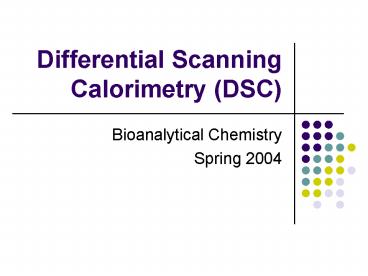Differential Scanning Calorimetry DSC - PowerPoint PPT Presentation
1 / 20
Title:
Differential Scanning Calorimetry DSC
Description:
Differential Scanning Calorimetry (DSC) ... Short dynamic and isothermal scan steps. Separate reversible and irreversible effects ... – PowerPoint PPT presentation
Number of Views:11663
Avg rating:5.0/5.0
Title: Differential Scanning Calorimetry DSC
1
Differential Scanning Calorimetry (DSC)
- Bioanalytical Chemistry
- Spring 2004
2
Thermal Analysis
- Differential Scanning Calorimetry (DSC)
- Measure heat absorbed or liberated during heating
or cooling
- Thermal Gravimetric Analysis (TGA)
- Measure change in weight during heating or
cooling - Thermomechanical Analysis (TMA)
- Measure change in dimensions during heating or
cooling
3
What Can You Measure with DSC?
- Qualitative analysis
- Fingerprinting of minerals, clays, polymers
- Sample purity
- Melting points
- Heat capacity, cp
- Glass transition temperature, Tg
- Crystallization temperature, Tc
- Phase diagrams
4
Where Used?
- Pharmaceutical industry
- Purity
- Food industry
- Characterization of fats and oils
- Polymer industry
- Synthetic blends
5
Schematic of DSC Instrument
Reference
Sample
T1
T2
Pt thermopile
Pt thermopile
Low mass 1 gram
heater
heater
N2 flow
DW
6
Variants of DSC
- Heat flux
- 1955 Boersma
- 1 large (30 100 g) furnace
- Power compensated
- Separate small (1 g) microheaters for sample and
reference - Hyper DSC
- Very fast scan rates 500C/min
- Mimic processing conditions
- StepScan DSC
- Short dynamic and isothermal scan steps
- Separate reversible and irreversible effects
7
Output of DSC
Thermogram
exo
Glass transition
dH/dt, mJ/s
melting
crystallization
endo
Temperature, K
8
Heat Capacity
- dqp/dt heat flow
- dT/dt heating rate
- (dqp/dt) / (dT/dt) dqp/dT cp
9
Temperature Program
- T(t) T0 a twhere T is temperature, a is a
constant and t is time - A t - Dynamic segment
- dT/dt
- T0 - Isothermal segment
- Constant temperature
10
Glass Transition
Thermogram
- Step in thermogram
- Transition from disordered solid to liquid
- Observed in glassy solids, e.g., polymers
- Tg, glass transition temperature
Glass transition
dH/dt, mJ/s
Tg
Temperature, K
11
Crystallization
Thermogram
- Sharp positive peak
- Disordered to ordered transition
- Material can crystallize!
- Observed in glassy solids, e.g., polymers
- Tc, crystallization temperature
Crystallization
dH/dt, mJ/s
Tc
Temperature, K
12
Melting
Thermogram
- Negative peak on thermogram
- Ordered to disordered transition
- Tm, melting temperature
- NB melting happens to crystalline polymers
glassing happens to amorphous polymers
Melting
dH/dt, mJ/s
Tm
Temperature, K
13
Analysis
Crystallization
- Sharp positive peak
- Disordered to ordered transition
- Observed in glassy solids, e.g., polymers
- Tc, crystallization temperature
dH/dt, mJ/s
Tc
Temperature, K
14
Instrumental Performance
- Blank test
- No sample, no reference
- Baseline provides info on
- Sample contamination
- Pt thermopile
- 4,4-azoxyanisole standard
- Netherlands Society for Thermal Analysis (TAWN)
- 2 endothermic transitions
- 117C
- 134C
- Resolution
- Return to baseline
- R 100 (1 ((dq/dt)min / (dq/dt)134C))
- Sensitivity
15
Resolution
Thermogram
exo
dH/dt, mJ/s
endo
Temperature, K
16
Instrumental Specifications
- Temperature range -170 to 730C
- Accuracy/precision ?0.1C/?0.01C
- Scan rates 0.01 to 500C/min
- 1 g indium (10C/min, N2 purge)
- Peak height 7.44 mW ? 0.15 mW
- FWHM 0.42 ? 0.10C
- H/W ratio 17.6 mW/C ? 1 mW/C
- Isothermal drift (10 min)
- -150C lt 15 µW
- 100C lt10 µW
17
Sampling
- Pan
- Al
- Au
- Glass capillary tubes
- Maximize contact between sample and pan
- Thin films
- Fine granules of uniform size
- Grind!
18
Calibration
- Calibrants
- High purity
- Metals
- In 156.4C
- Sn 231.9C
- Pb 327.4C
- Zn 419.5C
- Al 660.4C
- Inorganics
- KNO3 128.7C
- KClO4 299.4C
- Organics
- Triphenylmethane
- Polystyrene 105C
- Higher thermal conductivity than metals
- Accurately known enthalpies
- EX indium (5 10 mg)
- ?H(fusion) 6.80 cal/g, mp 156.4C
- K (Area/mass) ?H(fusion) 6.80 cal/g
- Not hygroscopic
- Not light sensitive
- High thermal stability
- Relatively unreactive
- Pan
- Atmosphere
19
Calibration
- 1 point
- 2 point
- Is wide temperature range being used?
20
References
- Mendham, J. Denney, R.C. Barnes, J.D. Thomas,
M.J.K. Vogels Textbook of Quantitative Chemical
Analysis 6th edition Prentice Hall Edinburgh,
2000. - McNaughton, J.L. Mortimer, C.T. In IRS
Physical Chemistry Series 2, 1975, 10, 1-44.
Differential Scanning Calorimetry. - Differential Scanning Calorimetry. Avail. At
URLwww.psrc.usm.edu/macrog/dsc.htm

